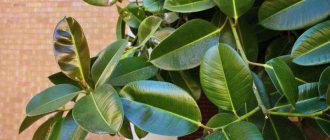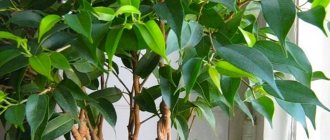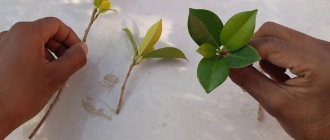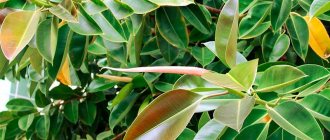The sacred fig plant (Ficus religiosa) is also popularly called ficus religiosa, Bodhi tree, sacred fig. This evergreen ornamental foliage plant is part of the genus Ficus, which belongs to the Mulberry family (Moraceae).
This plant is originally from India. It can also be found in Sri Lanka, Burma, Nepal, Thailand, the southwestern part of China, and also on the islands of the Malay Archipelago. At first, such a perennial was found only in evergreen and mixed jungles, and also on the plains. However, over the years it has become increasingly common in the mountains. Today, ficus can be seen at altitudes of up to 1500 m above sea level.
The name “sacred” was given to this ficus because in ancient times such powerful trees were planted near Buddhist temples. At the same time, they were cared for by clergy-monks.
An ancient legend says that Prince Siddhartha Gautama once rested under the crown of a ficus tree. And then inspiration descended on him. As a result, he began to call himself Buddha and began to preach Buddhism.
Features of ficus sacred
Ficus sacred differs from other representatives of the ficus genus in that this tree reaches very large sizes. The height of some specimens growing in favorable conditions can reach up to 30 meters. In indoor culture, the height of such a plant is about 300 cm.
Since this is a vigorous plant, it is most often used to decorate spacious rooms. So, it can be found in a greenhouse, concert hall or winter garden. The crown can grow up to 10 m in width, which is also not conducive to growing crops in a not very large apartment.
The young plant has a small number of aerial roots. Very often it begins its life as an epiphyte, with ficus growing on the trunks and branches of mature trees. Over time, the root system becomes more powerful and thick, and eventually the transformation into a banyan tree occurs.
Ficus can also begin its life as a lithophyte. He looks for a “cozy” place in the cracks of the building. In some of the photographs you can see that the tree seems to be growing into a building (for example, into a temple). After some time, the root system of the plant entwines itself with the structure and becomes almost one with it. The roots initially sink lower and lower until they reach the soil surface. After this, they begin to penetrate deeper and deeper into the soil.
Ficus sacred is a fast-growing plant. After 1–2 years, just one tree becomes more like a small forest: many thin trunks and one massive crown. Young plants are covered with brownish bark with a reddish tint. This color is similar to the color of the branches of ficus racemosus. As it grows, the color of the bark changes. An adult tree has a gray trunk and branches.
The shape of the sheet plates is original, and their surface is smooth. The surface of the foliage is so thin that it is almost transparent. The average length of the leaf plate is from 8 to 12 centimeters. In mature, very massive trees, the foliage reaches a length of about 20 centimeters. The width of the sheet plates can vary from 40 to 130 mm.
In a young plant, the foliage has a pale red tint, after some time it changes to greenish. If the place where the ficus grows is sunny, then when it becomes an adult, its foliage turns dark green with a bluish tint. Each plate is decorated with clearly visible whitish veins. The plant also has oval stipules, which are about 50 mm long. After the leaf plate has fully opened, the stipules fly off.
This plant has alternately arranged foliage. The length of its petioles is usually the same as that of the leaf blade itself, but they can be longer. If a tree grows in a place with fairly dry air, it changes its leaves twice a year.
During the flowering period, syconia, which are small brown inflorescences, form on the branches. Their shape is externally similar to a hemisphere. The average size of such an inflorescence is about 20 mm. Typically flowering occurs in the summer, but the Caribaea species blooms during the winter months.
In indoor culture, the average lifespan of ficus sacred is about 15 years. Under favorable conditions in the wild, the plant can live on average from 400 to 600 years.
Description of the plant
The plant has several names: sacred fig, ficus sacred, ficus religious. This evergreen tree belongs to the genus Ficus of the Mulberry family, or Moraceae. The places where this plant is widely distributed are India, Nepal, Sri Lanka, southwestern China and countries on the Indochina Peninsula.
Ficus of this species is characterized by the presence of strong and powerful branches with grayish bark. The leaves of the plant are heart-shaped, and their length can vary from 8 to 12 centimeters. The leaves have smooth edges, a long drip point and distinct veins. The inflorescences are bowl-shaped and form inedible purple inflorescences.
Brief description of cultivation
- Temperature . In the warm season - 18–23 degrees, and in the winter months the room should not be colder than 15 degrees.
- Air humidity . Its level should be very high. That is why the tree should be moistened regularly and very often with a spray bottle.
- Illumination . Requires good sunlight, but the tree should be protected from direct sunlight. When grown indoors, it is placed near a window with a western or eastern orientation.
- Watering . In the summer, the substrate in the pot is moistened systematically - 1 or 2 times every 7 days. In the cold season, you can reduce watering to once every 1–1.5 weeks. To do this, use well-settled water.
- Substrate . Loose, well-drained chernozem, rich in nutrients, is suitable.
- Fertilizer . From the beginning of spring until late autumn, the plant is provided with timely feeding with liquid fertilizer. It is recommended to alternately use mineral complexes and organic matter.
- Transplant . It is held once every couple of years from February to March.
- Reproduction . Easy to propagate by aerial roots and seed.
- Features of care . The plant is not resistant to pests. It is not recommended that a diseased plant be located near the ficus. While the bush is young, it will feel most comfortable in warmth and with high air humidity. If he is not provided with such conditions, then there is a high probability that he will not “live” with you for long.
Ficus sacred. [Hope and Peace]
Caring for ficus sacred at home
Ficus sacred is distinguished by its unpretentiousness. It grows quite normally in indoor conditions. But if you want to get a spectacular and healthy tree, then it will have to be provided with proper care and optimal conditions for growth.
Illumination
In order for the ficus to grow and develop normally, it needs bright sunlight, which should be diffused. Make sure that direct sunlight does not hit the tree. It can also be grown in slight shade.
The optimal lighting level for a plant is from 2600 to 3000 lux. The best place for it is located next to an east or west window. Remember that with excessively poor lighting, leaf fly may occur. If necessary, the bush can be illuminated with a phytolamp.
Temperature
This culture is distinguished by its heat-loving nature. In spring and summer, the optimal air temperature is 18–25 degrees. In winter, do not allow the room where the bush is located to be colder than 15 degrees. Also, in the cold season, it is recommended to move the ficus to a brighter place or provide additional lighting.
The sacred ficus does not need a period of rest. Even in the winter months, if the necessary temperature and humidity are provided, its growth and development will be the same as in summer. The bush is placed as far as possible from working heating devices, it is also protected from drafts and frequent moves to a new location are not allowed.
Air humidity
In nature, this ficus prefers to grow in places with high air humidity. That is why for normal development and growth in indoor culture it requires high humidity. The plant needs systematic moistening of the foliage from a spray bottle. However, this method of increasing humidity is quite problematic for large trees. In this case, a household air humidifier can help you out, or you can place the bush near a decorative pond, or even an aquarium.
Watering
The plant needs to be watered regularly and abundantly. To do this, it is recommended to use well-settled water. In the warm season, the substrate in the pot is moistened 1 or 2 times every 7 days. In the winter months, watering is carried out once every 1–1.5 weeks. Make sure that liquid does not stagnate in the substrate.
Remember that you need to water the ficus only after the top layer of the substrate has dried thoroughly. Some time after watering, drain the excess water that has flowed into the pan. Remember that the plant tolerates short-term drought more easily than stagnant water in the substrate. With proper care and adherence to the watering regime, the plant develops a strong root system, which is extremely important in bonsai culture.
Substrate
For ficus sacred, a loose and nutritious soil mixture is suitable. The optimal composition of the substrate: leaf and turf soil, as well as sand (2:2:1). It is recommended to add a small amount of charcoal to it. An earth mixture consisting of peat, leaf and turf soil, as well as sand, taken in equal parts, is also suitable. In this case, the pH of the finished substrate should be 6.0–6.5.
When planting the tree, be sure to provide a good drainage layer at the bottom of the pot. It is best to pour expanded clay at the very bottom, and cover it with sand on top.
Top dressing
This tree does not require regular fertilization. However, it is still recommended to feed it once every 2 weeks. At the same time, experienced gardeners recommend using organic and mineral fertilizers alternately. Please note that the fertilizer must have a high content of nitrogen and potassium.
Transplanting a sacred ficus
This plant is characterized by rapid growth. In just 12 months, a small seedling can turn into a two-meter tree. That is why while the tree is young, it requires regular and fairly frequent replanting (1-3 times a year).
Replanting is carried out only if necessary, when the root system becomes very crowded in the container. An adult large ficus cannot be replanted. Instead, the top layer of substrate is systematically replaced with fresh soil mixture.
Sacred Ficus Bengalensis Audrey
Trimming
The stems must be trimmed systematically. This allows you to restrain the growth of the ficus, and also helps maintain a neat appearance of the crown. Trim the tree shortly before the growing season begins. Then, if necessary, you can pinch the tops of young branches.
In order for the crown to be beautiful and neat, it is necessary to give the branches the desired direction. This can be done using a wire frame. The stems of this plant are very elastic, and therefore even an inexperienced gardener will not have problems with the formation of the crown.
Bloom
Ficus flowering is quite unusual. Formed inflorescences look like an empty pot. Something similar to brown moss appears on the inner surface of this “cauldron”. Scientifically, this inflorescence is called a pseudofruit, or syconia. They are located in the leaf axils in pairs.
The surface of the inflorescences and leaf blades is smooth. Pollination occurs with the help of a special type of wasp - blastophages. If pollination is successful, green inflorescences are formed, after some time they turn dark burgundy or purple. Such fruits are inedible.
How to care
Caring for the religious ficus is not particularly difficult, so even a novice gardener can provide it at the proper level, the main thing is to adhere to some subtleties regarding the requirements of decorative culture.
Watering
Use soft water at room temperature. Preferably filtered or settled for several days.
Irrigation is carried out as the soil surface dries, while paying attention to the pan - liquid should not accumulate in it.
Additionally, once every 1-2 days, spray with a spray bottle, after which the leaf plates are wiped with a lint-free rag, thereby removing settled dust.
Feeding
Feed the ficus in spring and summer 1-2 times a month. Complex preparations with a high content of nitrogen and potassium, which are necessary for the plant in the active growth stage, are used as fertilizers.
The products are used only after irrigating the substrate, so as not to injure the roots or cause burns.
Trimming and shaping
The tops need to be pinched
Due to the active growth of the crop, it is necessary to prune young shoots in a timely manner. The procedure is carried out before the ficus begins to intensively stretch in height. In the future, it is enough to lightly pinch the shoots.
The formation of the crown can be done using another method. The branches of Eden are plastic, so they can be directed in the desired direction by constructing a special frame of dense wire.
When placing several specimens in a pot, the trunks can be intertwined like a braid, thus creating a decorative composition.
Reproduction methods
Growing from seeds
Propagation of ficus sacred by seeds is the most accessible and simplest. Fill the container with a mixture of sand and peat, sow the seeds and moisten the substrate well. Cover the top of the crops with glass or film.
The first shoots, as a rule, appear after 5–7 days. After this, the shelter is removed so that the plant gets used to room conditions. After the formation of the first pair of true leaves, the seedlings must be planted in separate pots. If you take a container with a diameter of 10 to 15 centimeters, then several seedlings can be planted in it at once.
Ficus from seeds. My observations. [Hope and Peace]
Cuttings
Such a tree can also be propagated by apical cuttings, but they take root rather reluctantly. The length of the cuttings should reach from 15 to 18 centimeters. Each of them should have at least 3 pairs of healthy leaf plates. The cuttings should be 2 times longer than the foliage. In spring, cuttings are planted in a greenhouse in a substrate consisting of perlite and peat or sand and soil. It is necessary to maintain the air temperature around 25 degrees.
When rooting in room conditions, the segments are covered on top with plastic film. Immediately before planting for rooting, the cut of the cutting is treated with Heteroauxin or Kornevin. Provide the cuttings with diffused lighting. The shelter is removed after half a month. The rooted segment must be transplanted into a not very large container.
THE SECRET OF QUICK ROOTING OF FICUS! How to properly cut ficus. Ficus propagation
Peepal breeding
The flower can only be propagated using seeds or cuttings. Seeds can be purchased at any flower shop. The packaging should say "Ficus Sacred Eden". Most experts say that if you plant seeds, out of 100% of those planted, 90% will grow. This is considered the most accurate breeding option for peepal.
Tree cuttings will take root within 14 or 28 days. It is far from a fact that every settlement will survive. But the system of such plantings is much stronger than that of seeds. And cuttings are a faster way to get ficus at home.
Diseases and pests
Most often, ficus sacred gets sick only when there are violations in care. In this case, special attention should be paid to young bushes. Their foliage is still very small, and their shoots are thin. The death of the stems can be caused by inappropriate temperature conditions or lighting, as well as a lack of nutrients.
Quite often, flower growers complain that the ficus sheds its leaves. This is his reaction to any change in care. However, you need to take into account that foliage can fly around for no reason; this is due to the peculiarity of a particular specimen.
Most often, aphids, thrips, mealybugs and scale insects settle on the plant. To get rid of them, spray the plant with a suitable pesticide. Remember to take precautions.
Ficus. Basic types and care at home | Biologist's advice
Pests and diseases
If the flower is in low humidity conditions, the following pests may appear:
- scale insect;
- spider mite;
- mealybug.
After detecting pests, you should immediately treat the plant with a special product, acting very carefully.
Thin shoots with small leaves - lack of light or nutrition.
Root rotting is caused by excess moisture in the soil.
Dry leaves along the edges with brown spots in the center - constant exposure to direct sunlight.
Leaves fall - draft or temperature change.
Important! At the age of 2-3 years, the ficus sheds its leaves on its own.
We also recommend reading other interesting articles about plants in the bonsai category: brachychiton, microcarpa, portulacaria, polyscias.











